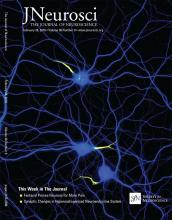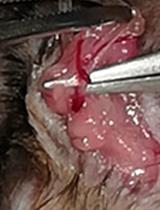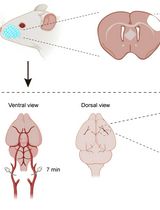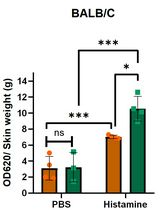- EN - English
- CN - 中文
Artificial Inhalation Protocol in Adult Mice
成年小鼠人工吸气方法
发布: 2018年09月20日第8卷第18期 DOI: 10.21769/BioProtoc.3024 浏览次数: 6036
评审: Oneil G. BhalalaTanveer AhmadEhsan Kheradpezhouh
Abstract
Research in the area of in vivo olfactory physiology benefits from having direct access to the nasal airways through which odorants can be presented. Ordinarily, the passage of odorants through the airways is controlled by respiratory rhythm. This fact makes it difficult to control the timing and strength of an olfactory stimulus, since animals must breathe regularly, and the act of breathing itself also controls odorant presentation. However, using an artificial inhalation preparation allows us to decouple breathing from olfaction. With this technique we present oxygen and anesthetic (if desired) to the lungs directly and independently control odorant access to the nasal passages. This technique allows for direct control of odorant presentation in vivo, enabling more precise control of parameters of stimulation when investigating olfactory processing. This technique may have additional applications, for example in aerosolized drug delivery.
Keywords: Inhalation (吸入)Background
Olfaction, aerosolized drug delivery, and many facets of airway humidification and homeostasis are governed by active respiration through the nasal passages. Basic research into these areas benefits from being able to actively control respiration in an anesthetized preparation. Our lab focuses in part on how active respiration controls olfactory coding in the olfactory bulb, which is the site of the first synapse in the neurobiology of odor perception. To address questions along this front in anesthetized mice, we employ an artificial respiration strategy that decouples airflow through the nasal passages from gas exchange with the lungs. This type of preparation allows experimentally manipulating nasal airflow while simultaneously delivering oxygenated air (usually incorporating a dilute aerosolized general anesthetic) to the lungs, thus producing a stable in vivo preparation that can last for eight hours or more.
This protocol is modified from an earlier form that has been briefly outlined in previous publications (Wachowiak and Cohen, 2001; Vučinić et al., 2006). Our lab and others have used this or a similar technique to investigate odor processing in the olfactory bulb of anesthetized rodents for several years (e.g., Sobel and Tank, 1993; Wachowiak and Cohen, 2001; Spors et al., 2006; Bathellier et al., 2008; Wachowiak et al., 2013; Rothermel et al., 2014; Economo et al., 2016). Here, we provide a detailed protocol for this method with the goal making it more easily adopted, and we expect that it may even find uses outside of the community working on olfactory physiology in rodents.
Materials and Reagents
- Surgical thread, 6-0 Silk Suture Thread (Surgical Specialities, LOOKTM, catalog number: SP102 )
- Micro swabs (Absorbent Points #501) (Henry Schein, catalog number: 9004693 )
- Razor blade (Exel Surgical Blades) (Exel International, model: #11, catalog number: 29502 )
- Trachea Tubing, 0.034” x 0.050” x 0.008” (A-M systems, catalog number: 801900 )
- Sniff Tubing, 0.045” x 0.062” x 0.0085” (A-M systems, catalog number: 802500 )
- Sniff Connector, 0.04” ID, 0.085” OD (Dow Corning, SilasticTM, catalog number: 508-005 )
- T-junction tubing connector (about ¼” diameter), connected to flexible tubing (Tygon)
- Y-connector (Grainger), 1/16” (for connecting and then splitting the sniff tubing)
- Adult M or F mice (we use C57/Bl6, but any strain should work) of healthy weight (~20-40 g)
- Super Glue (Henkel, Loctite, catalog number: LOCTITE 404 )
- 0.5% bupivacaine (Marcaine, Hospira Inc.)
- Ketamine/xylazine cocktail
- Isoflurane (VetONE Fluriso)
- Nair (Church and Dwight Co.)
- Denture/Dental Cement (Teets Cold Cure, Co-Oral-Ite Dental Mfg Co.)
Equipment
- Isoflurane vaporizer (VetEquip)
- 3-way solenoid valve (Cole-Parmer, catalog number: EW-01540-11 )
- Soldering iron
- A vacuum line or other way of generating vacuum
- Custom-cut steel headbar
Note: We use one that is roughly omega-shaped, but many shapes would suffice. Should be roughly 0.5 mm thick. - Heating pad
- Two flow meters (Aalborg) (one of which is capable of 500 ml/min, the other of which is capable of 1 L/min or more)
- Pressure sensor (Honeywell, catalog number: ASCX01DN or similar), mounted to circuit board and connected to Sniff Tubing via Y-connector
- Tank of Compressed Oxygen Gas
- Very fine surgical scissors (Roboz Surgical Instrument, catalog number: RS-5610 )
- Fine Forceps (Fine Science Tools, model: Dumont #5 )
- 8" x 8" breadboard (ThorLabs)
Procedure
文章信息
版权信息
© 2018 The Authors; exclusive licensee Bio-protocol LLC.
如何引用
Readers should cite both the Bio-protocol article and the original research article where this protocol was used:
- Eiting, T. P. and Wachowiak, M. (2018). Artificial Inhalation Protocol in Adult Mice. Bio-protocol 8(18): e3024. DOI: 10.21769/BioProtoc.3024.
- Diaz-Quesada, M., Youngstrom, I. A., Tsuno, Y., Hansen, K. R., Economo, M. N. and Wachowiak, M. (2018). Inhalation Frequency Controls Reformatting of Mitral/Tufted Cell Odor Representations in the Olfactory Bulb. J Neurosci 38(9): 2189-2206.
分类
神经科学 > 感觉和运动系统 > 动物模型
神经科学 > 神经解剖学和神经环路 > 动物模型
细胞生物学 > 组织分析 > 生理学
您对这篇实验方法有问题吗?
在此处发布您的问题,我们将邀请本文作者来回答。同时,我们会将您的问题发布到Bio-protocol Exchange,以便寻求社区成员的帮助。
提问指南
+ 问题描述
写下详细的问题描述,包括所有有助于他人回答您问题的信息(例如实验过程、条件和相关图像等)。
Share
Bluesky
X
Copy link












